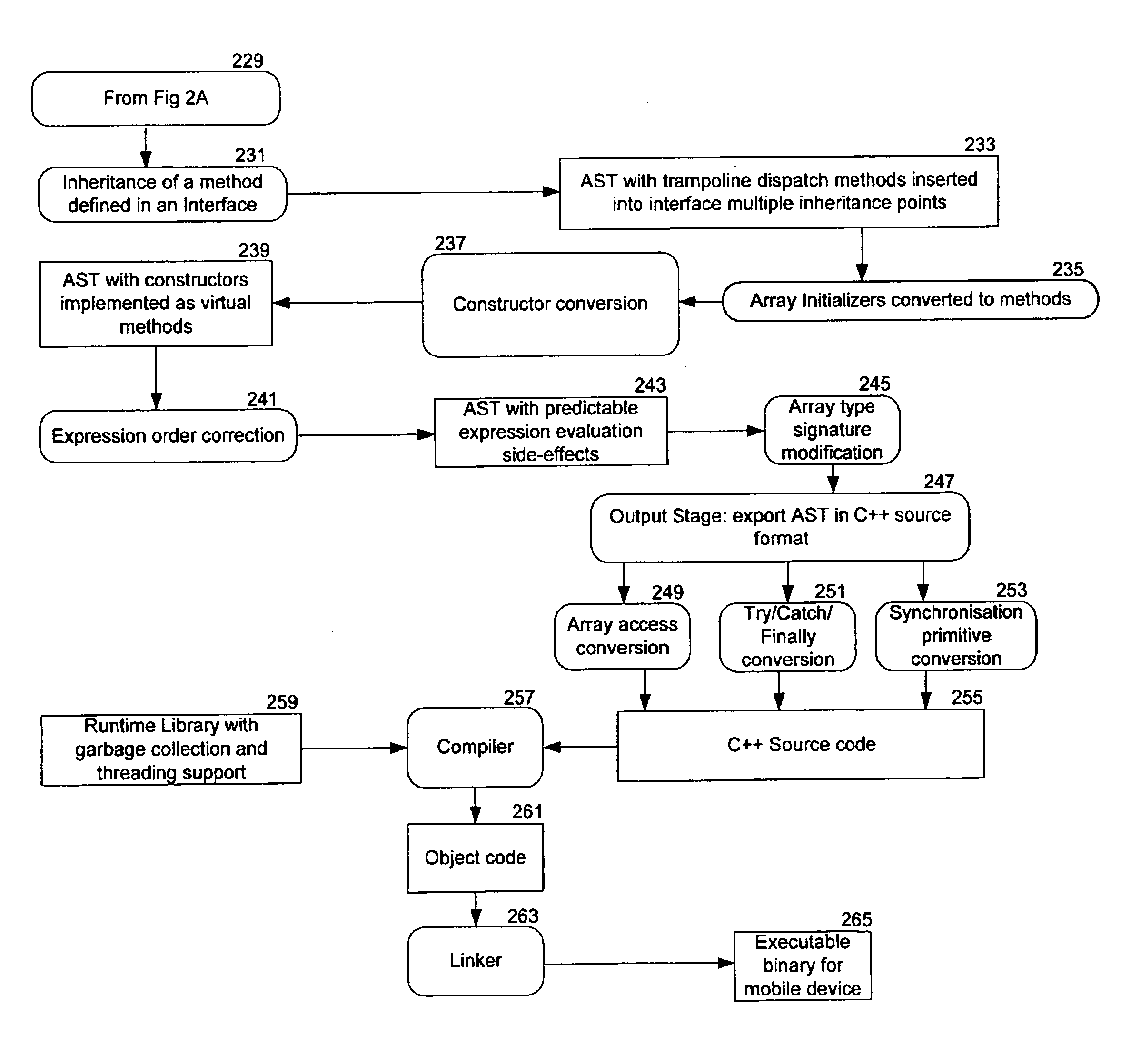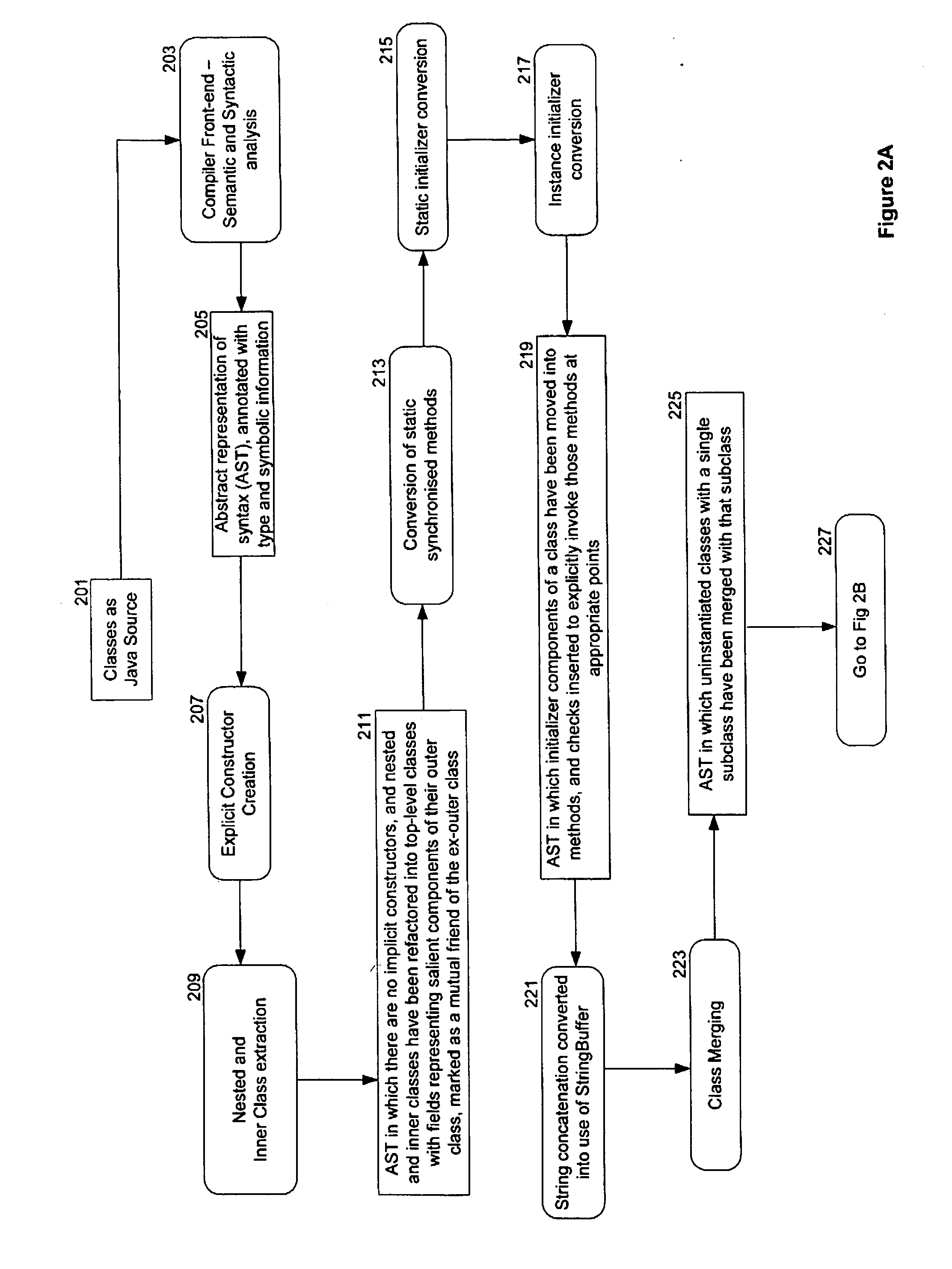Software translation
a software translation and software technology, applied in the field of software translation, can solve the problems of reducing the control of the quality of the ported application, increasing the number of developers, and reducing the time to market, so as to improve the cost effectiveness, facilitate debugging, and improve the effect of time-to-mark
- Summary
- Abstract
- Description
- Claims
- Application Information
AI Technical Summary
Benefits of technology
Problems solved by technology
Method used
Image
Examples
examples
[0231]Examples are given as a pseudo-Java textual rendering of the AST, using C++ style to represent constructs that are not valid in Java.
[0232]Addition Expression
[0233]In this example, evaluation of a++ and a−− in differing orders would result in different values of the addition expression.
BeforeAfter{ ...{int fresh1; ... (a++ + a−−)(fresh1=a++, fresh1 + a−−)... }... }
[0234]Method Call
[0235]In this example, early evaluation of (var=otr) would change the object on which the method is invoked. otr is not extracted, as it conflicts with neither the use of nor the assignment to var.
BeforeAfter{ ...{T1 fresh1, fresh2; ...var.meth(otr, var=otr)(fresh1=var,... } fresh2=(var=otr), fresh1.meth(otr, fresh2))... }
[0236]Assignment Altering Variable
[0237]In this example, the expression being assigned to ‘a’ changes the value of ‘a’.
BeforeAfter{ ...{int fresh1; ...a = a++(fresh1=a++, a=fresh1)... }... }
[0238]Conflicting Field-Access Assignment
[0239]In this example, the evaluation of c( ) could ...
example method
[0250]An example of a procedure to detect methods that may be translated as non-virtual is as follows:
For each method M in the AST, do: If M is private, then M is non-virtual. Otherwise, if M is abstract, then M is virtual. Otherwise, if there exists a non-private method of the same signature as M in a class or interface C where C is a subtype of the class declaring M, then M is virtual. Otherwise, if there exists a non-private method of the same signature as M in a class or interface D where D is a supertype of the class declaring M, then M is virtual. Otherwise, M is non-virtual.
EXAMPLE
[0251]
JavaC++ headersclass A{class A{ private void ameth( ){ }private: abstract void anabsmeth( ); void ameth( ); public void apublicmeth( ){ }public: public void anothermeth( ){ } virtual void anabsmeth( ) =}0;class B extends A{ virtual void apublicmeth( ); public void apublicmeth( ){ } void anothermeth( ); public void moremeth( ){ }}; public void evenmoremeth( ){ }class B:...
example
[0287]
Beforeint aMethod(int i){ while(true){ try{ if(i == 1) break; if(i−− == 2) continue; if(i == 3) return i; else throw new Exception( ); } catch(Exception e){ return 10; } finally{ i = 6; } } return i+1;}After (C++)int aClass::aMethod(int i){ bool doReturn = false; bool doBreak = false; bool doContinue = false; int returnValue = 0; do{ while(true){ { bool caught_exception=false; java_lang_Exception* exception = setjmp(push_new_try_location_jump_buffer( )); bool throw_after_finally=false; do{ if(non_exception(exception)){{ if(i == 1){ doReturn = false; doContinue = false; doBreak = true; break; } if(i−− == 2){ doReturn = false; doContinue = true; doBreak = false; continue; } if(i == 3){ doReturn = true; returnValue = i; doBreak = false; doContinue = false; } else longjmp(current_exception_jump_b...
PUM
 Login to View More
Login to View More Abstract
Description
Claims
Application Information
 Login to View More
Login to View More - R&D
- Intellectual Property
- Life Sciences
- Materials
- Tech Scout
- Unparalleled Data Quality
- Higher Quality Content
- 60% Fewer Hallucinations
Browse by: Latest US Patents, China's latest patents, Technical Efficacy Thesaurus, Application Domain, Technology Topic, Popular Technical Reports.
© 2025 PatSnap. All rights reserved.Legal|Privacy policy|Modern Slavery Act Transparency Statement|Sitemap|About US| Contact US: help@patsnap.com



